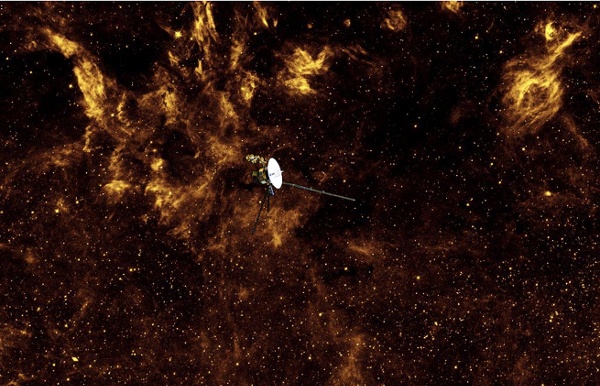



Pioneer plaque The illustration on the Pioneer plaque The Pioneer plaques are a pair of gold-anodized aluminium plaques which were placed on board the 1972 Pioneer 10 and 1973 Pioneer 11 spacecraft, featuring a pictorial message, in case either Pioneer 10 or 11 is intercepted by extraterrestrial life. The plaques show the nude figures of a human male and female along with several symbols that are designed to provide information about the origin of the spacecraft.[1] The Voyager Golden Record, a much more complex and detailed message using (then) state-of-the-art media, was attached to the Voyager spacecraft launched in 1977. History[edit] The original idea, that the Pioneer spacecraft should carry a message from mankind, was first mentioned by Eric Burgess when he visited the Jet Propulsion Laboratory in Pasadena, California, during the Mariner 9 mission. Sagan was enthusiastic about the idea of sending a message with the Pioneer spacecraft. The actual plaque Physical properties[edit] Symbolism[edit]
Voyager Golden Record Cover of the Voyager Golden Record The Voyager Golden Records are phonograph records which were included aboard both Voyager spacecrafts, which were launched in 1977. They contain sounds and images selected to portray the diversity of life and culture on Earth, and are intended for any intelligent extraterrestrial life form, or for future humans, who may find them. The Voyager spacecrafts are not heading towards any particular star, but Voyager 1 will be within 1.6 light-years of the star Gliese 445, currently in the constellation Camelopardalis, in about 40,000 years.[1] As the probes are extremely small compared to the vastness of interstellar space, the probability of a space-faring civilization encountering them is very small, especially since the probes will eventually stop emitting electromagnetic radiation meant for communication. Background[edit] The Voyager 1 and 2 probes are currently the farthest man made objects from Earth. Contents[edit] Playback[edit] Materials[edit] Film[edit]
Fermi paradox A graphical representation of the Arecibo message – Humanity's first attempt to use radio waves to actively communicate its existence to alien civilizations The Fermi paradox (or Fermi's paradox) is the apparent contradiction between high estimates of the probability of the existence of extraterrestrial civilization and humanity's lack of contact with, or evidence for, such civilizations.[1] The basic points of the argument, made by physicists Enrico Fermi and Michael H. Hart, are: The Sun is a young star. There are billions of stars in the galaxy that are billions of years older;some of these stars probably have Earth-like planets[2] which, if the Earth is typical, may develop intelligent life;presumably, some of these civilizations will develop interstellar travel, a technology Earth is investigating even now, such as that used in the proposed 100 Year Starship;at any practical pace of interstellar travel, the galaxy can be completely colonized in a few tens of millions of years.